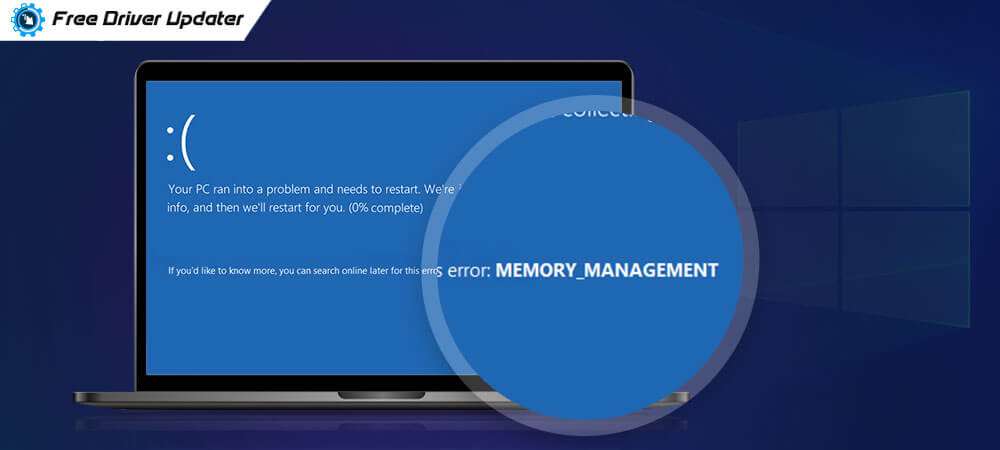
- WINDOW BLUE SCREEN MEMORY MANAGEMENT UPDATE
- WINDOW BLUE SCREEN MEMORY MANAGEMENT DRIVER
- WINDOW BLUE SCREEN MEMORY MANAGEMENT SOFTWARE
- WINDOW BLUE SCREEN MEMORY MANAGEMENT CODE
- WINDOW BLUE SCREEN MEMORY MANAGEMENT PC
WINDOW BLUE SCREEN MEMORY MANAGEMENT DRIVER
BIOS updates can be found on your manufacturer’s website, and driver updates can either be done manually through Device Manager or with our Driver Reviver software. And Click on Start, type in mdsched.exe, and give permission to the tool to check your computer memory for errors.
WINDOW BLUE SCREEN MEMORY MANAGEMENT CODE
Stop Code Memory Management Error Easy Solutions Choose the Windows Memory Diagnostic Tool will run its check immediately or on your next reboot. Press Windows key + R on your keyboard to open the Run launch box, type in MdSched, then press OK or hit the Enter key.Ĭlick Restart now and check for problems to immediately run a boot-level check of your RAM, or click Check for problems the next time I start my button. It’s a good thing, windows come with a tool that can test your RAM and let you know if there are any issues with it. SFC Scanner will now run through your computer system, seeing if it finds any errors to fix. You can solve it by Right-click the Start button, and run ‘Command Prompt’ in admin mode.Ī slightly intimidating black text box will pop-up. Sometimes SFC scanner creates some issues. You can try this way to solve the stop code memory management error. It is only logical that issues involving such an important component can manifest themselves into serious problems, such as BSODs. It plays a critical role in the image display and video rendering processes in Windows. The video card driver is the driver that handles operations involving the graphics card and programs.

The video card driver is of interest to us because it is the driver most likely to be involved in blue screen crashes, never mind a BSOD involving the memory management function in Windows.

You should know this: A driver is a set of code that defines or controls the interactions between hardware devices and software. Well, the procedure here is supposed to target the problem for this particular case.
WINDOW BLUE SCREEN MEMORY MANAGEMENT UPDATE
Stop Code Memory Management Fixes Update Video Card Driver If not, there might be a chance it was a one-off.
WINDOW BLUE SCREEN MEMORY MANAGEMENT PC
If you suffer a Memory Management BSOD, restart your PC and view if the error returns. There are many well-known reasons for memory management errors:Īt times, your system probably recovers after a reset. Just put, a memory management BSOD means there’s been a crucial stop code memory management error. And when it crashes, it takes your PC with it. After you close a program, it again assigns that memory to other processes or checks it available for use.Īlso, memory management can’t release PC errors, just like the rest of your PC. Also, it decides how much memory to assign (and how much is available for allocation). It manages or organizes the memory transition and processes b/w your RAM and physical memory while execution. Memory management can tracks every memory section on your PC, besides status. When memory management went wrong, your system displaying BSODs at regular intervals. Properly working memory management, however, is essential to your system health. Memory management is the function that organizes your system memory. Memory management is necessary to keep your OS marking perfectly.

Let’s discuss, here are some suggestions that have worked well.
WINDOW BLUE SCREEN MEMORY MANAGEMENT SOFTWARE
There can be any fault in RAM, Corrupted file system, Software or hardware conflict, outdated hardware, Disk errors, Error in BIOS, and so on. There are several possible reasons to stop code memory management errors. And, whenever it gets crashed you will get a memory management error notification. However, if an error occurs in memory management then the process is stopped, and it may crash the OS as well, due to which system displays a blue screen of error (BSOD). In Memory Management, once the process is executed, it allocated memory to some other process. It also ‘frees up’ memory when you close any program on your computer. It decides how much memory to allocate to certain processes including your launched program, and when to give it to them. Memory management is the function that manages your complete system memory.


 0 kommentar(er)
0 kommentar(er)
